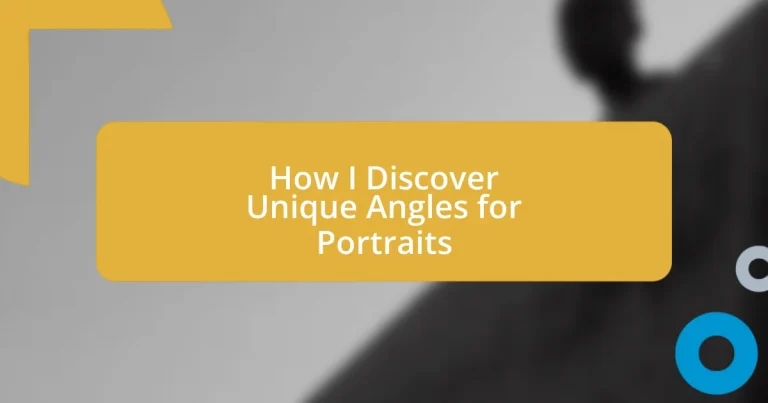Key takeaways:
- Unique angles significantly influence the emotional impact of portraits, with different perspectives evoking various feelings and narratives.
- Lighting is crucial in enhancing angles, transforming ordinary shots into captivating images, and influencing the mood of the portrait.
- Experimenting with unconventional positions leads to striking compositions that reveal deeper emotions and storytelling elements within portraits.
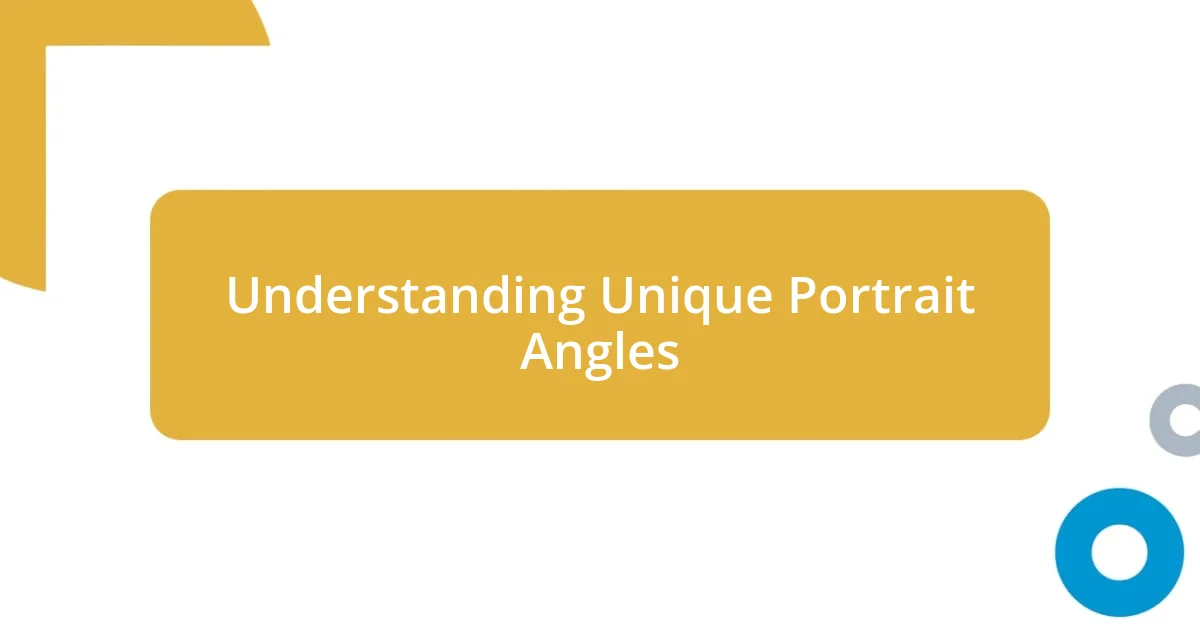
Understanding Unique Portrait Angles
Understanding unique portrait angles is crucial for creating striking images that resonate with viewers. I remember the first time I tilted my camera slightly downward while photographing a friend. The result was this stunning perspective that seemed to draw the viewer into her world, capturing an intimacy I hadn’t achieved before.
When I consider the impact of angle, it makes me wonder: why do some portraits evoke stronger emotions than others? Exploring angles can truly transform a photograph—an overhead shot can create a sense of vulnerability, while a low angle might empower the subject. These subtle shifts prompt me to think about how each angle can tell a different story.
I’ve also experimented with using negative space around my subjects. It was during a late afternoon shoot in a wide-open field that I realized how a simple change in angle could highlight not just the person in the frame, but also the surroundings, making them pivotal characters in the narrative. Isn’t it fascinating how one change can influence the entire feeling of the portrait?
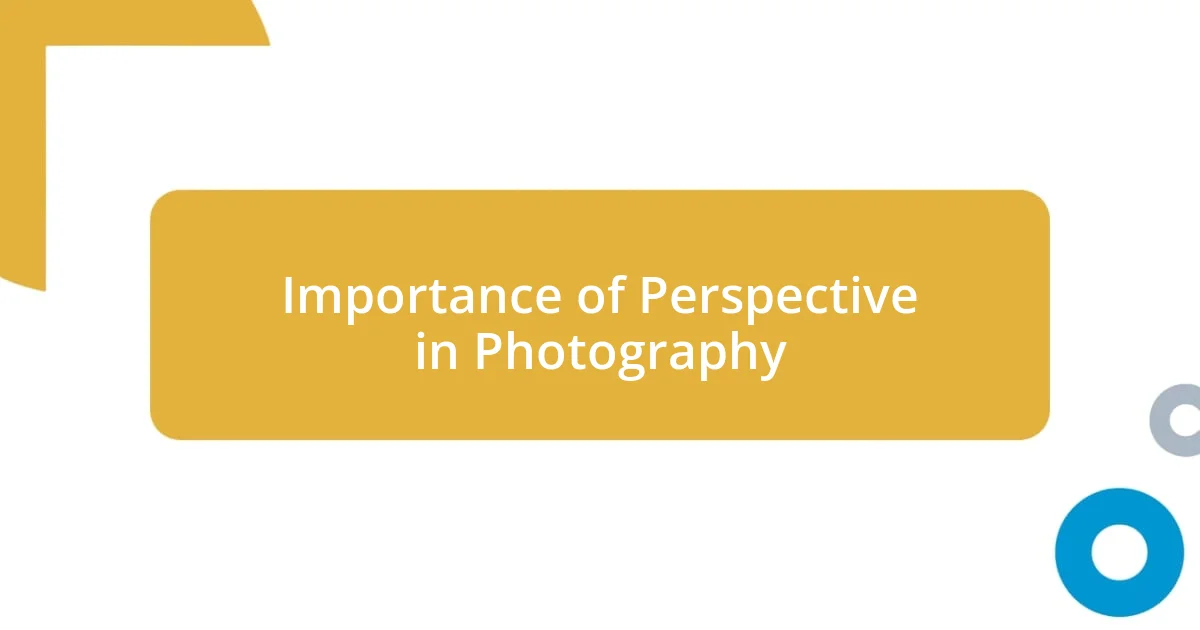
Importance of Perspective in Photography
Perspective in photography shapes how we connect with the subject. I distinctly remember a day at the beach, where I decided to kneel while photographing my sister. The result was a mesmerizing shot that not only included her laughter but also the crashing waves behind her, creating a sense of joy and freedom. That angle, closer to the ground, made the viewer feel part of that moment.
When I’m behind the camera, I often ask myself: how does this angle impact the story being told? I find that shooting from above can add a layer of detachment, while getting right up close enhances intimacy. Just last week, I practiced this by focusing on the delicate features of a friend’s face. The difference was striking; seeing her emotions up close conveyed depth and authenticity that a wider shot simply couldn’t capture.
Moreover, I find it essential to consider light and shadows in relation to perspective. Once, during a golden hour session, I positioned my subject to catch the fading sunlight. The angle I chose not only illuminated her features beautifully but also cast intricate shadows that added drama and interest. This experience reinforced my belief that the right perspective can elevate a portrait from ordinary to extraordinary.
| Perspective Type | Emotional Impact |
|---|---|
| High Angle | Can create feelings of vulnerability or submission |
| Low Angle | Conveys power and dominance |
| Eye Level | Establishes connection and relatability |
| Close-Up | Enhances intimacy and emotional depth |
| Wide Shot | Provides context and emphasizes surroundings |
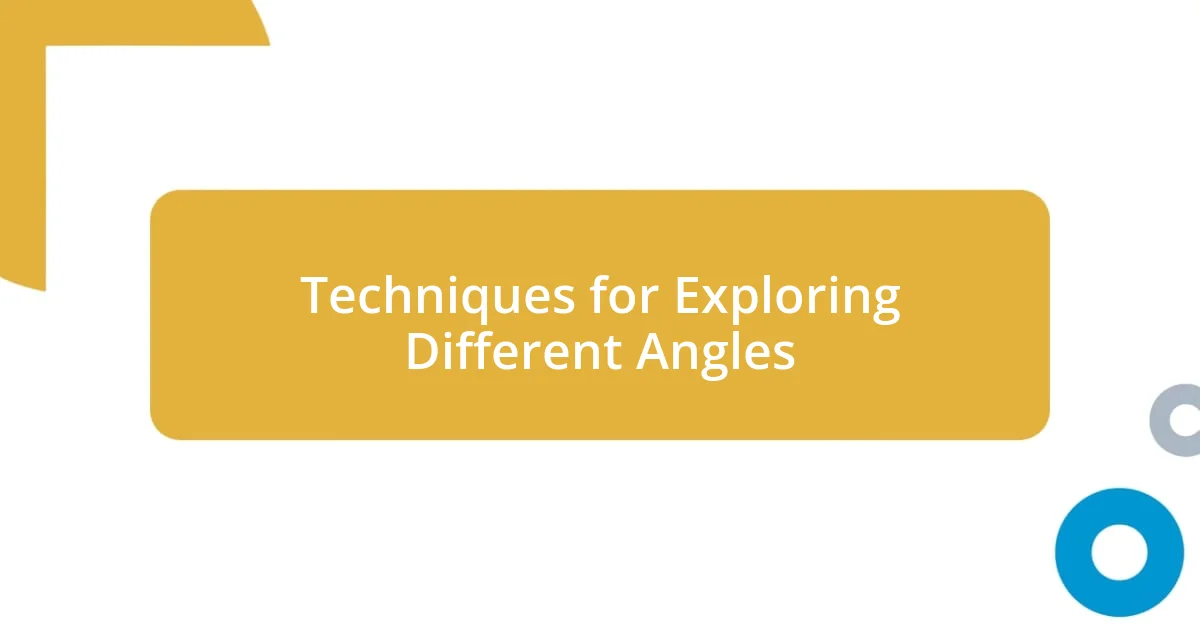
Techniques for Exploring Different Angles
When I’m out shooting, experimenting with angles can be an exhilarating process. One evening, I decided to climb onto a nearby bench at a park for a different perspective of my friends gathering. This elevated angle not only captured the joy on their faces but also included the sunset in the backdrop, adding warmth and vibrancy to the moment. It was as if being above them allowed me to observe their connection from a new lens.
Here are a few techniques I often find useful for exploring different angles during a shoot:
- Get Low: Kneeling or lying down shifts the perspective dramatically. It can elevate the subject’s prominence against the background, making them stand out.
- Change Your Height: Utilizing ladders or benches offers a fresh viewpoint, revealing details that might remain hidden from eye level.
- Use a Tilted Angle: Tilting the camera, or using Dutch angle shots, can create a sense of energy or tension, drawing the viewer into the scene.
- Walk Around the Subject: Moving around allows me to discover the most flattering angles. Each step often reveals something new I didn’t initially see.
- Incorporate Reflections: Finding surfaces such as water or mirrors can frame the subject in a compelling way, adding an artistic element to the portrait.
By combining these techniques, I’m constantly reminded of how angles can redefine the narrative in every portrait, allowing the story to unfold in fascinating ways.
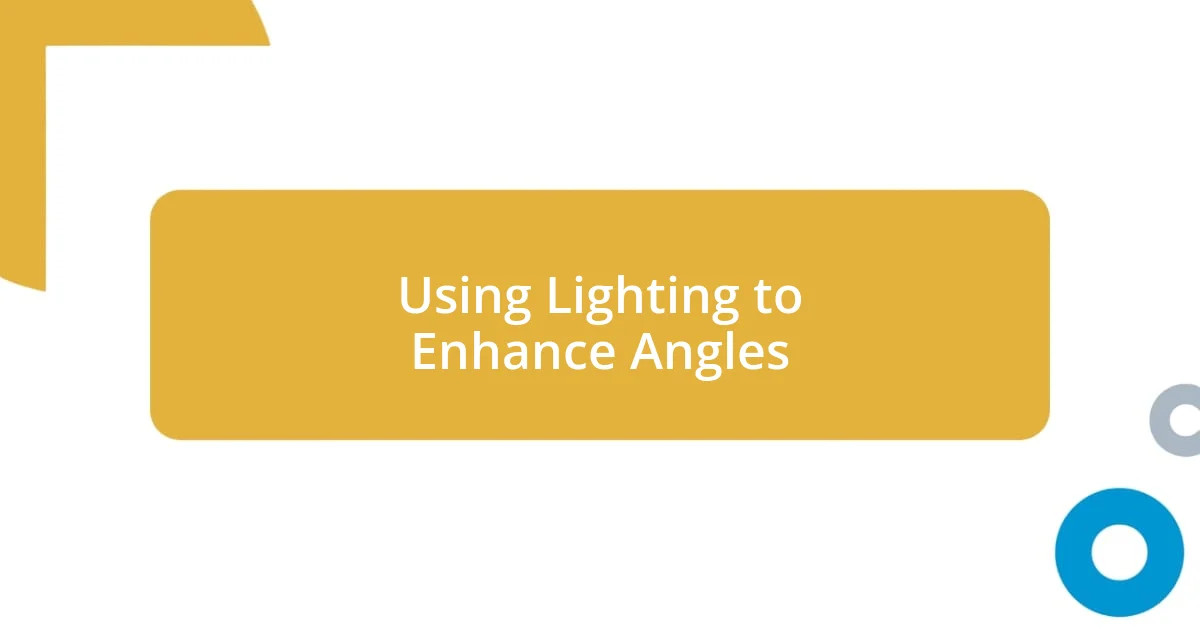
Using Lighting to Enhance Angles
Lighting plays a crucial role in enhancing angles, often transforming an ordinary shot into something truly captivating. I remember a portrait session where I used backlighting during an early morning shoot. The sun filtered through the leaves, creating a halo effect around my subject’s hair. That simple change made the angle I chose—slightly off-center—suddenly feel magical. It cast playful shadows that danced on her face, rendering her emotions rich and dynamic.
I’ve also found that experimenting with different light sources can alter the mood significantly. For example, using a soft diffused light can help lift shadows, making my subject appear softer and more gentle. Conversely, harsh lighting, like direct sunlight, creates dramatic shadows that can convey strength or even tension. It’s fascinating to play with these contrasts; I once set up a shoot in an alleyway during lunchtime. The stark shadows formed by the tall buildings added a gritty edge to the angles I captured, instilling an urban vibe that perfectly reflected the subject’s personality.
Have you ever stopped to consider how shadows can become allies in storytelling? I certainly have. I recently shot a portrait as I positioned my friend in front of a textured wall while the late afternoon sun cast long shadows behind her. It was incredible how those lines added depth and complexity to the image, culminating in an angle that not only highlighted her features but also narrated a story of resilience and strength. Lighting, when orchestrated thoughtfully with angles, becomes an essential player in enhancing the portrait experience.
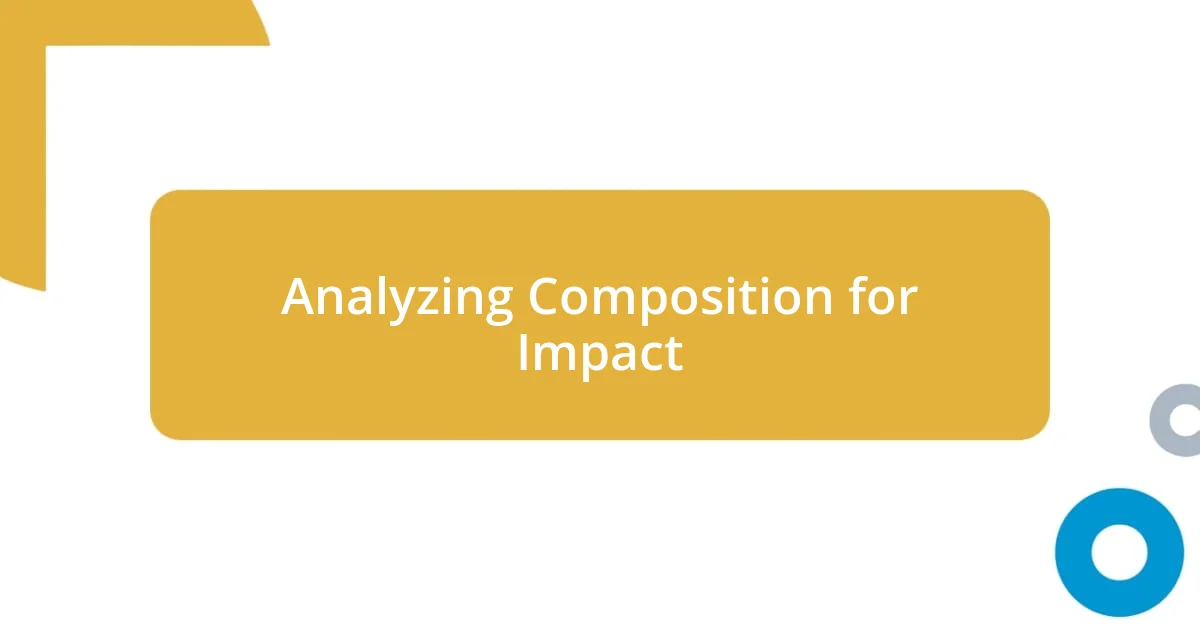
Analyzing Composition for Impact
Analyzing composition in portrait photography is an art form that speaks to me on many levels. I remember one time standing in front of a friend during a stormy evening, the dark clouds looming overhead. By placing her slightly off-center in the frame, I was able to juxtapose her bright yellow raincoat against the menacing sky. This simple compositional technique drew the viewer’s eye straight to her expression of determination despite the chaos unfolding around us, reinforcing the narrative of resilience.
When I analyze composition, I often focus on the rule of thirds, a technique where I mentally divide my frame into a grid of nine equal sections. It’s as if I’m creating a roadmap for the viewer’s gaze. I once captured a candid moment of a child blowing dandelion seeds, and by placing the child on one of those intersecting lines, I felt the image flowed naturally. This placement brought balance and allowed the viewer to absorb both the child’s joy and the delicate seeds scattering into the wind, illustrating the fleeting nature of childhood.
There’s also something profoundly powerful about negative space in a portrait. I recall a shoot where I intentionally left a vast area of empty sky above my subject. This design choice emphasized her solitude and introspection, allowing the viewer to ponder what thoughts filled her mind. Isn’t it fascinating how composition can evoke emotions just as strongly as the subject’s expressions? For me, the careful analysis of composition isn’t just technical; it’s about telling a richer story through the visuals we create.
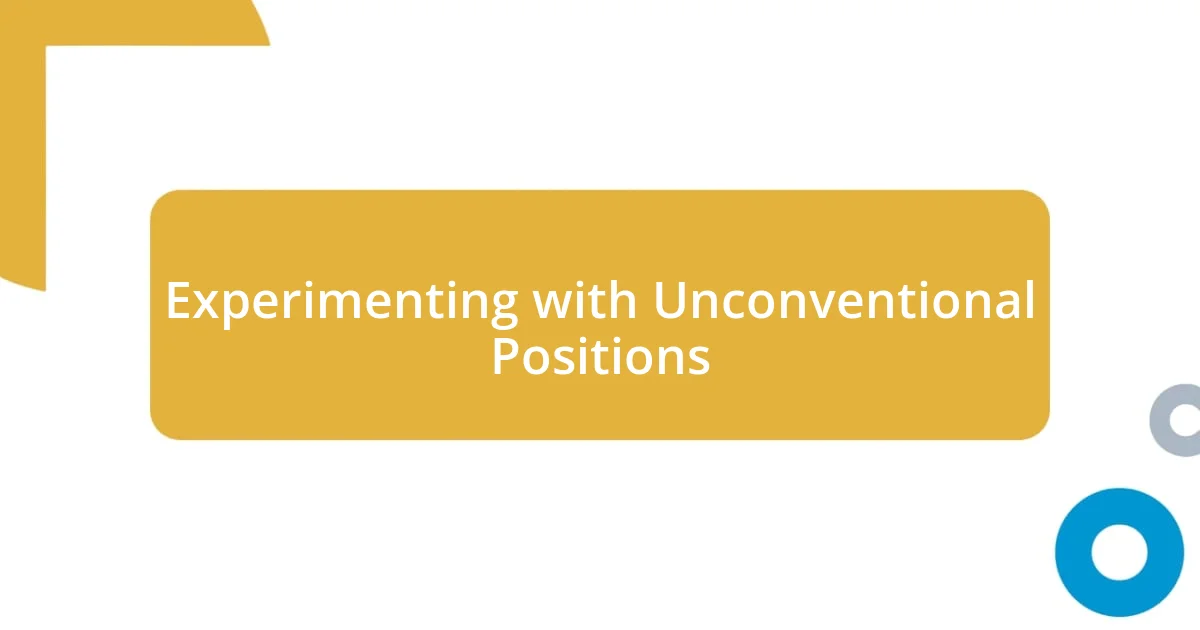
Experimenting with Unconventional Positions
Experimenting with unconventional positions can yield some of the most striking portraits I’ve had the pleasure of capturing. I once decided to lower my camera to the ground, shooting upwards at a friend who was jumping in the air. The angle not only exaggerated her laughter but also framed the vibrant sunset behind her, creating an exhilarating sense of freedom. It’s amazing how a small shift in perspective can pump so much energy into an image.
During another session, I asked my subject to recline on a staircase, angling her head backward to look playfully at me. This unconventional position added a layer of intrigue and allowed for some incredibly dynamic lines in the composition. It’s like taking a little risk—you can uncover emotions that might be missed in traditional poses. I often ponder, how much more can we convey by simply flipping the script on typical portraiture?
I also enjoy rotating the camera itself to capture profiles from unexpected perspectives. I recall a moment when I shot a friend while she leaned against a wall, tilting my camera to create a somewhat abstract portrayal. This slight twist transformed a standard portrait into an expressive work of art that, to me, captured the essence of her personality. Does it not make you wonder how often we limit ourselves to conventional methods, missing out on creative opportunities? By embracing unconventional positions, I’ve discovered that there’s a world of artistry waiting to be explored right beyond the familiar frame.
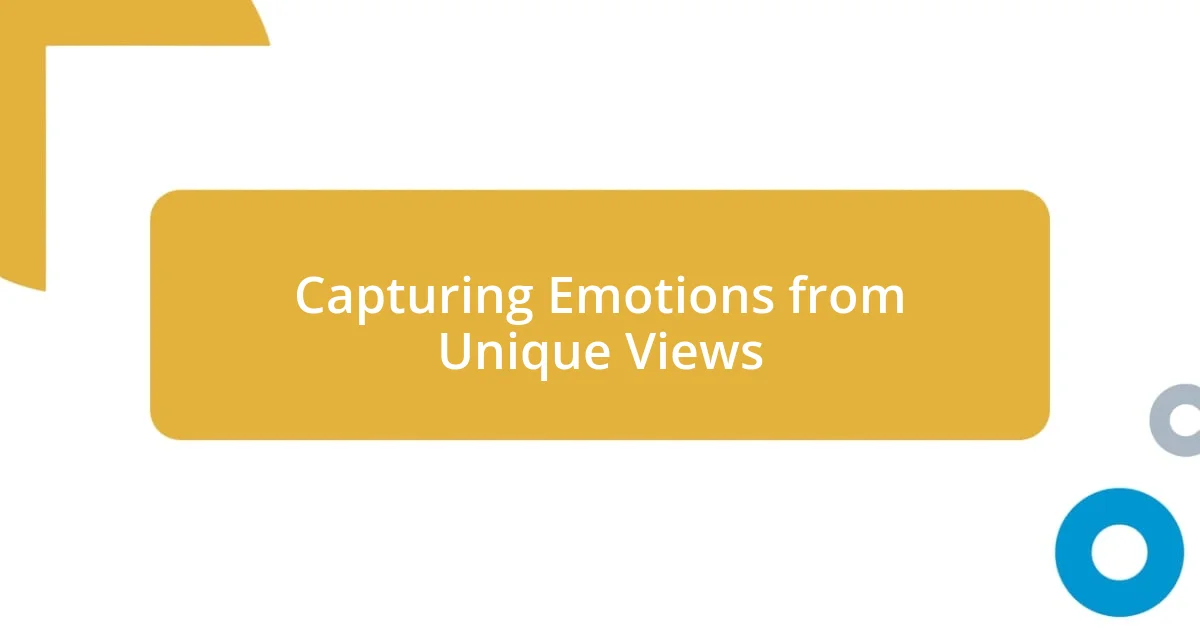
Capturing Emotions from Unique Views
Capturing emotions from unique views allows me to tell stories that resonate deeply with viewers. I remember a rainy day when I decided to shoot from a lower vantage point, capturing my sister as she stood under her umbrella. The droplets caught the soft glow of the streetlights, creating a magical bokeh effect that surrounded her. In that moment, her expression of tranquility amidst the downpour painted a vivid narrative about finding calm in chaos.
One of my favorite techniques is framing my subject through elements in their environment. While photographing a dancer framed by the arches of a bridge, I noticed how the curvature echoed her graceful movements. That framing not only added depth but also highlighted the emotional intensity of her performance. Isn’t it compelling how an angle can elevate an already powerful moment into something truly unforgettable?
I also explore emotions by varying the distance from my subjects. During a portrait session with an old friend, I started with wide shots that captured our surroundings before moving in closer for intimate expressions. The transition revealed layers of nostalgia—her smile reflected our shared memories, while the distant shots balanced those emotions with our environment. This interplay made me realize that emotion doesn’t just come from a face; it’s woven into the context. How often do we overlook that in our pursuit of capturing the perfect portrait?












